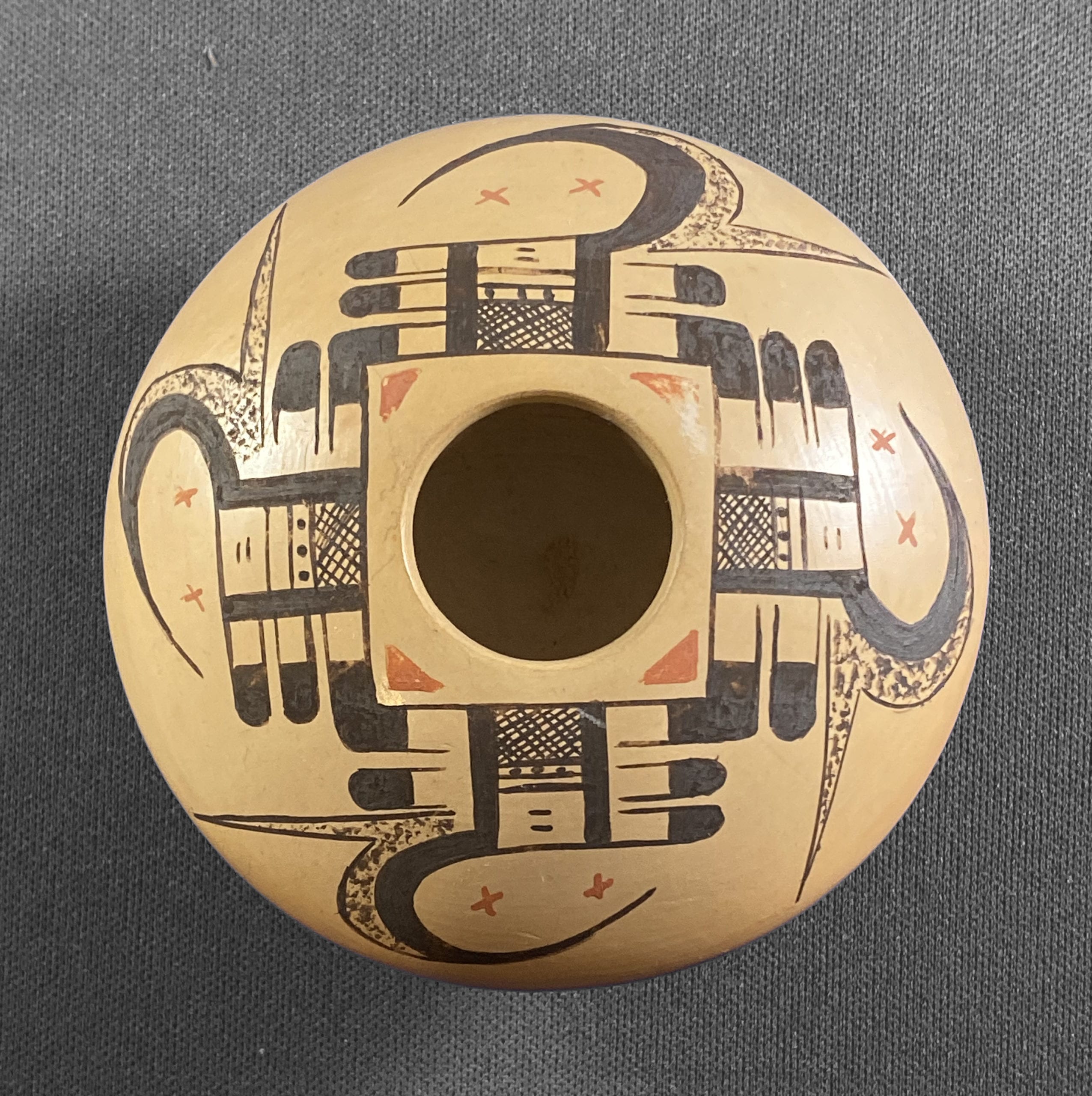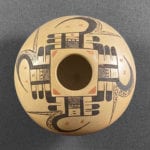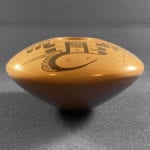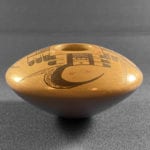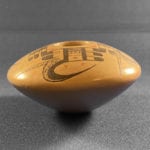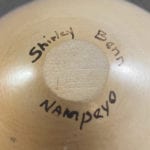This minature seedpot has fairly thick walls and thus substantial weight for its size. A slight blushing on one section of the bottom indicates that it was outdoor fired. 40% of the height of the jar is above its waist (the widest point); 60% below. The distance from the mouth of the jar to the waist is only 1.25 inches. It is within this narrow band that Shirley painted her complex design.
The major design element on 2018-06 is a version of the “bird hanging from sky band” design first seen in this collection on Nampeyo’s bowl 1993-04. (See “Category List” for other pots in this collection with this design.) The design is repeated on all four sides of the mouth of the jar with the base of linear “sky band” elements touching and thus forming an open square around the jar’s mouth. In the four corners of this square float small red triangles. Two are somewhat worn.
The linear sky band element consists of three layers linked by a central rectangular form. On both sides of this central rectangle are thick black lines followed by rows of linear tails with unpainted bases and black tips.
The layout of the central rectangle is a bit complex, especially given the small scale of the seedpot. Across the midsection of each rectangle is a “two lane highway” element frequently used by Nampeyo, Shirley’s great grandmother. The top lane contains three dots; the bottom lane left blank. Above is a cross hatched area formed by two sets of about ten parallel lines intersecting at an angle. Two sets of lines repeated four times equals eight times that Shirley had to draw parallel lines in a minuscule space. In only one rendition do these lines deviate from parallel and touch. The square below the midsection is left unpainted, except for two short parallel lines forming a equal sign.
Only half of the bottom row of linear tails is present. What would be the left tail in the set is replaced by a mostly curvilinear design, interpreted in the literature as an abstract bird. This avian image has two parts. The inner element is a solid black sickle-shaped form, its handle the thick line abutting the left side of the central rectangle and continuing below with a curved blade with a point that nearly touches the set of linear tails to the right. Fitted along the outside curve of the sickle is a speckled form. The top of this form is a thin isosceles triangle in the position of the missing linear tail but three times longer. The point of this triangle almost reaches the edge of the seedjar. From its base the speckled design continues in the form of a small curve that hugs the back of the black sickle but is only half as long. The point where the speckled curve stops but the black curve continues is also at the edge of the seedjar.
In the space between the curved avian design and the linear tails Shirley has drawn two small red Xs. Since the “bird hanging from sky band” design is repeated four times, eight small Xs grace the pot, They and the four red triangles around the mouth of the jar provide only slight bits of color in the otherwise monochromatic design.
Seen by itself without scale, the precision of the painting on this seedpot is so exact that it is precise even when the image of the pot is greatly enlarged: extraordinary.
Shirley’s mother, Daisy Hooee, was Nampeyo’s granddaughter and lived an unusual life. (See the “Artist List” for pots by Daisy and to read her story.) Somewhat before 1920 Nampeyo’s sight became substantially impaired and her female descendants began to paint her pots and signed her name on the bottom. (See “Artist List” entries for “Nampeyo signed” for such pots in this collection.) The literature attributes most of this painting to Fannie, Nampeyo’s youngest daughter. When the “E” in “Nampeyo” is capitalized, I believe Fannie was the relative painting Nampeyo’s pots. When the “e” was not capitalized I think a different relative did the painting. More often than is often recognized in the literature, I believe Daisy painted pots for her blind grandmother, generally using Nampeyo’s style and signing using a small “e”. See “Appendix E” for a detailed discussion of pots signed with the name “Nampeyo.”
Seedpot 2018-06 is evidence that both Nampeyo’s ability and style were inherited by Shirley from her mother.. In Appendix B I define six design strategies that characterize the painting of the mature Nampeyo. Shirley used a bit more than three of the five relevant Nampeyo strategies:
1. A tension between linear and curvilinear elements, often represented as a contrast between heavy and delicate elements.
Linear/curvilinear tension between the linear feathers and the curved avian design is inherent to Shirley’s design.
2. A deliberate asymmetry of design.
Asymmetry is not seen on seedpot 2018-06. The same design is used by Shirley on all four sides of the jar.
3. The use of color to integrate design elements.
The use of small red triangles around the mouth and the red X marks under the avian curve encourage the viewer’s eye to view the full width of design as an intergrated whole.
4. The use of empty (negative) space to frame the painted image.
Although the size of her clay canvass is small and her design complex, Shirley leaves substantial negative space under the avian curve and between repetitions of the design.
5. The use of a thick above a thin framing line on the interior rim of her bowls.
This criterion is not relevant since 2018-06 is not a bowl
6. Confident, bold, and impulsive painting.
Shirley must have been confident to attempt such a detailed design in such a small space and her confidence was well-placed. Unlike Nampeyo, however, her painting is not “bold” but rather light and detailed. Also unlike her great grandmother, Shirley was not impulsive about her painting but carefully controlled her small yucca brush.
In short, much of the visual appeal of seedpot 2018-06 is the result of an aesthetic shared over four generations of Nampeyo artists. Shirley Benn (b.1936) was raised by her mother Daisy Hooee to be a potter but now is best known as a jewler. Neverthelerss she occasionally makes pottery, though Schaaf, (1998:116) suggests she worked with clay only from 1950 to 1980. Shirley lives at Zuni with her husband and excels at making the micro-mosaic jewlery for which the pueblo is famous. Perhaps because of the exactness required by her jewlery, her pottery shows a precision of detail that is extrtaordinary. Nowhere is this better illustraated that by seedpot 2018-06. See the Artist List for other pot by Shirley in this collection.

